With shortages in some grocery stores and less access to all our normal foods, have you found yourself wondering how you can continue to feed your family with healthy food when money is tight? This post is about how you can serve healthy food while on a budget.
In fact – a strict budget can actually work in your FAVOUR health-wise.
Read on to find out how. And download the free PDF of healthy budget meals from the pop-up form on this page.
Subsidized food
These days it costs less to go through a typical drive-through and buy a burger and fries than it does to buy vegetables and fruit.
It’s always cheaper to bring a packet of biscuits to a get-together than to bring a fruit platter. It’s much cheaper to buy a bag of lollies (‘sweets’ or ‘candy’ for the non-Aussies amongst the readers) than to make your own cake or slice.
Commercially-produced food is often subsidised. Once we start cooking from scratch in our own kitchens – it can get expensive.
How, then, can we eat healthy food when we are on a budget?
Food shortages
Due to the Covid-19 self-isolating and the hoarding of many people, many healthy foods are short in stores. In some parts of the country, there is limited access to fresh vegetables and fruit.
This is not a new phenomenon. During wars, similar problems often occur.
During World War Two, many occupied countries, including Norway, had their farm animals taken away by the German army for its soldiers. The result was that the citizens had to eat what food was available. Look at the result below:

In China, Mao Tse Tung inherited a country wracked by poverty. Establishing a ration system, each family had access to only about 40g. meat per family per week. The result was a high plant-based diet with subsequent low chronic disease rates. (The economic mismanagement of the ‘Great Leap Forward’ brought about a temporary reversal of this positive trend, however, as famine increased mortality).

This does not, however, change the facts that when people have historically had access to limited meat, the deprivations result in lowered chronic disease rates (as long as they still have enough food overall). When people are forced to eat less meat and more basic plant foods, for whatever reason – health improves.
Whole plant foods make your body run better, whatever condition it is in. Even adding a couple of pieces of fruit a day makes a difference to your health twenty years on. All the science shows that eating more plants can cause improvement to most health conditions.
When I have gone to the grocery stores and seen the shelves empty of beans and rice, I feel hopeful. The health of Westerners will improve if they eat the food they have squirrelled away. Maybe people will actually get healthier due to the Coronavirus.
Read on for ideas of how to prepare these basic plant foods that have kept people alive and healthy for centuries.
The most affordable dietary pattern that exists
I have a wonderful coffee table book called <Hungry Planet>. It follows families living in almost every country on earth. Each family has a photo taken of their family with all the food they would consume in a week. They then describe how they would prepare the food and their thoughts on food. Have a flip through the photos on this website (click on the book title above) – it is captivating!
In Bhutan, for example, we find the 13-person Namgay family who live in a tiny hillside village in the Himalayas, basing their diet on local red rice with a lot of chillis. They milk a family cow to make some cheese, and butter for tea, and eat dried fish or dried meat once or twice a month. Otherwise, everything eaten is a vegetable, fruit or nut. This costs them about $5 a day for the family (the value of their own homegrown foods is estimated at $29 US per week).

The 9-person Ayme family in Equador base their diet around potatoes, rice with a lot of plantains and some lentils. They too have a family cow which provides them with milk when not dry, but no access to any meat, fish or eggs. They drink stinging nettle tea. Typical meals are potato soup and barley porridge. Weekly food expenditure is around $31 US.
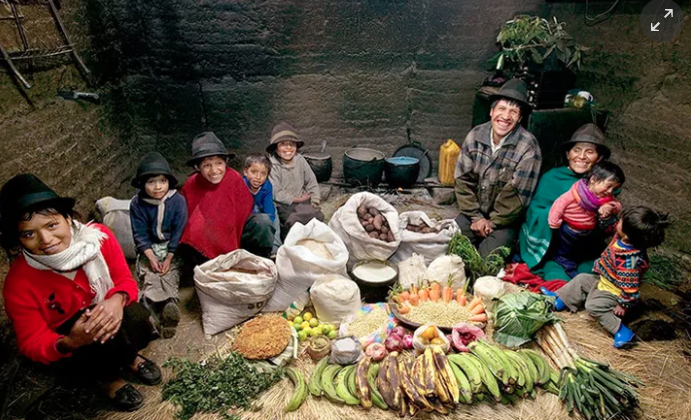
The 14-person Natomo family of Mali base their diet on corn, millet and rice. They have little access to milk, and use some dried fish occasionally when they can afford it. The rest of the diet is plant-based – mostly tomatoes, okra and onions. This costs them around $27 US per week.
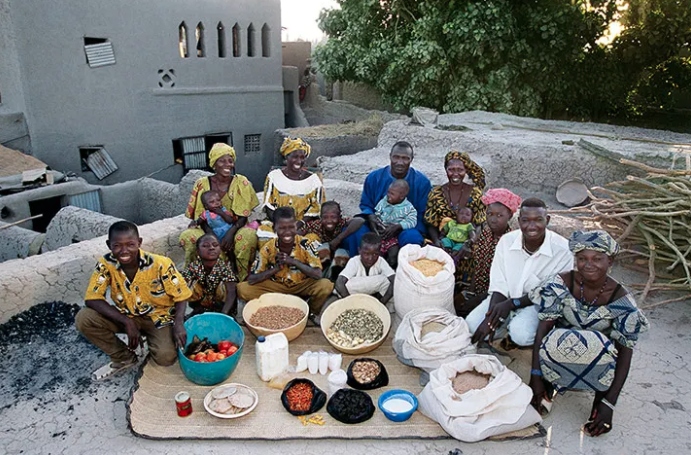
We do not need to emulate these exact diets to live on a budget. These pictures simply show that it is certainly affordable to eat mostly whole plant foods in order to stick to a tight budget.
Processed plant foods
If there is one name with which I have been branded but wish I had not been, it is the name ‘vegan’. I’m not ashamed to associate myself with kindness to animals and am quite vocal about the treatment of modern dairy cows and their young. However, I am sorry, by inference, to be associated with the processed foods which are part and parcel of many vegan diets. Processed foods have brought a great deal of suffering and illness to humans, and can be the undoing of a healthy vegan diet.
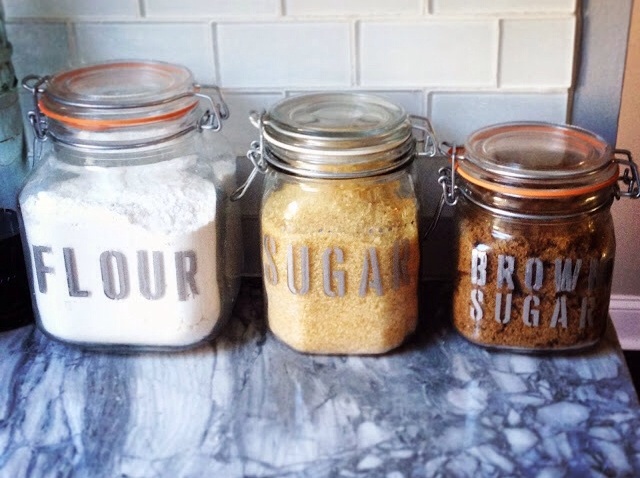
I do not encourage the regular eating of processed foods – even if they have no animal products in them. Coconut flour, coconut oil and other cold-pressed oils, vegan-“cheeses”, dried superfoods, vegan chocolate, faux-meats.
While these might be tasty additions to the diet, they are not only unnecessary for a healthy diet, but they are often quite expensive. I doubt the families living in Mali, Ecuador and Bhutan eat many of them. And we don’t need to either.
Vegetarian ‘Superfoods’
Plant-based eating seems to be marketed in this country by young people making smoothies with exotic (and expensive) superfoods. People seem to think that each meal should include goji berries, chia seeds, coconut flakes, amaranth, quinoa and out-of-season fruit. And I enjoy using some of these products as much as the next person!
If you put aside these supposed ‘superfoods’, however, and start eating basic whole-plant supermarket foods, you will find you actually save a good deal on your weekly grocery budget. Meals made of beans, rice, potatoes, spinach, canned tomatoes and curry powder or other spices and whatever other vegetables are on hand is the most cost-effective way to make plant-based meals. And it is also the healthiest. It’s really not too hard to cook healthy food on a budget.
It’s fun trying exotic foods, but not necessary for health. Here’s some <recipe books> I like – when the stores ARE better stocked.
One day of low-cost meals
These foods I describe below may not look the same as the food you usually serve – but are full of nutrition and health factors. They may not be TV cooking show recipes – but are most likely a lot healthier than those foods.
| Breakfast: Oats. Porridge. Add some sultanas and a tablespoon of ground flaxseeds and some chopped fruit (frozen berries are good, but pear or banana is also). Maybe flaxseeds are expensive – but one bag will last one person many months. Frozen berries are about $4 a bag – but again, it will last some time at 1/2 cup at a time. Add soy milk, almond milk or oat milk. These cost more than cow’s milk – but you don’t need to drink them throughout the day – just on your cereal. Or make your own oat milk (recipe to follow). Cook the cereal with water to keep costs down and add milk at the table. Alternatives are Weetbix, overnight (cold) oats, muesli (with under 5g sugar per serve), or a smoothie. | Lunch. Buying salad vegetables whole is more cost-effective than pre-chopped, bagged items. It just means you have to chop more and will likely have a different looking salad each day, depending on what was on sale where you bought them. Pre-cooking whole bags of beans and freezing them costs less than buying canned beans, but you can buy canned beans in bulk when on sale. A little vinegar and olive oil with some salt can make a simple dressing. I finish this off with in-season fruit. |
| Dinner. This is perhaps the least expensive part of the meal – just the opposite to if you are eating a meat-based diet. A soup or stew based on lentils or beans, or seasonal steamed vegetables with rice and tofu or beans does not cost a lot. Follow that up with a piece of fruit and you’re done. | Snacks. Just eat large substantial meals and most people won’t need to snack. If you DO need to snack, take advantage of seasonal fruit, cooled baked potatoes or meal leftovers. |
Accessing Healthy Food
Not everyone is able to afford organic, free-range, grass-fed meat. Our planet is not even large enough to provide such meat to every one of its citizens. Basic plant foods, however, are sustainable and affordable for almost anyone.
A healthy diet should be within reach of everyone, regardless of wealth. Unfortunately, food deserts have sprung up around the world, many in inner cities as well as in nations labouring under dictatorships and war. It is the work of aid organisations and governments to remedy these dire situations.

Outside of these situations, there is practically no one who is not able to access potatoes, rice, green leafy vegetables, lentils, spices and other basic plant foods. Health food on a budget is within the reach of most people.
During the Corona virus outbreak of 2020, access to even healthy food has become difficult for many of us. Canned tomatoes disappeared from supermarket shelves for weeks, as did canned and dried beans, rice, pasta and lentils. Some parts of the world are struggling to purchase sufficient fresh vegetables, and fruit is also hard to come by in some places.
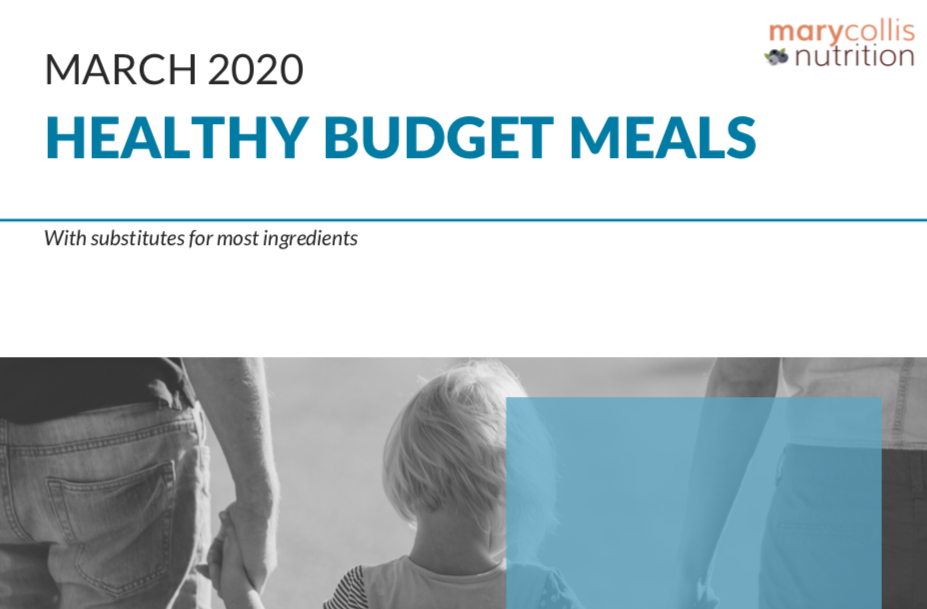
This free download of some simple meals to put together during lean times, with alternatives for when the grocery shelves are quite bare – may be helpful in continuing to put healthy and inexpensive meals on our tables.
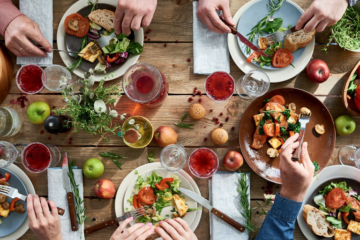
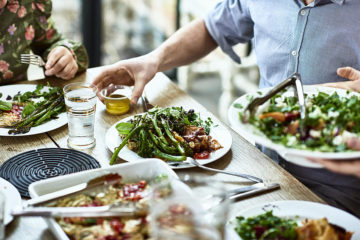

1 Comment
Bec · April 20, 2020 at 2:05 pm
Loved this read! Only just found your website.